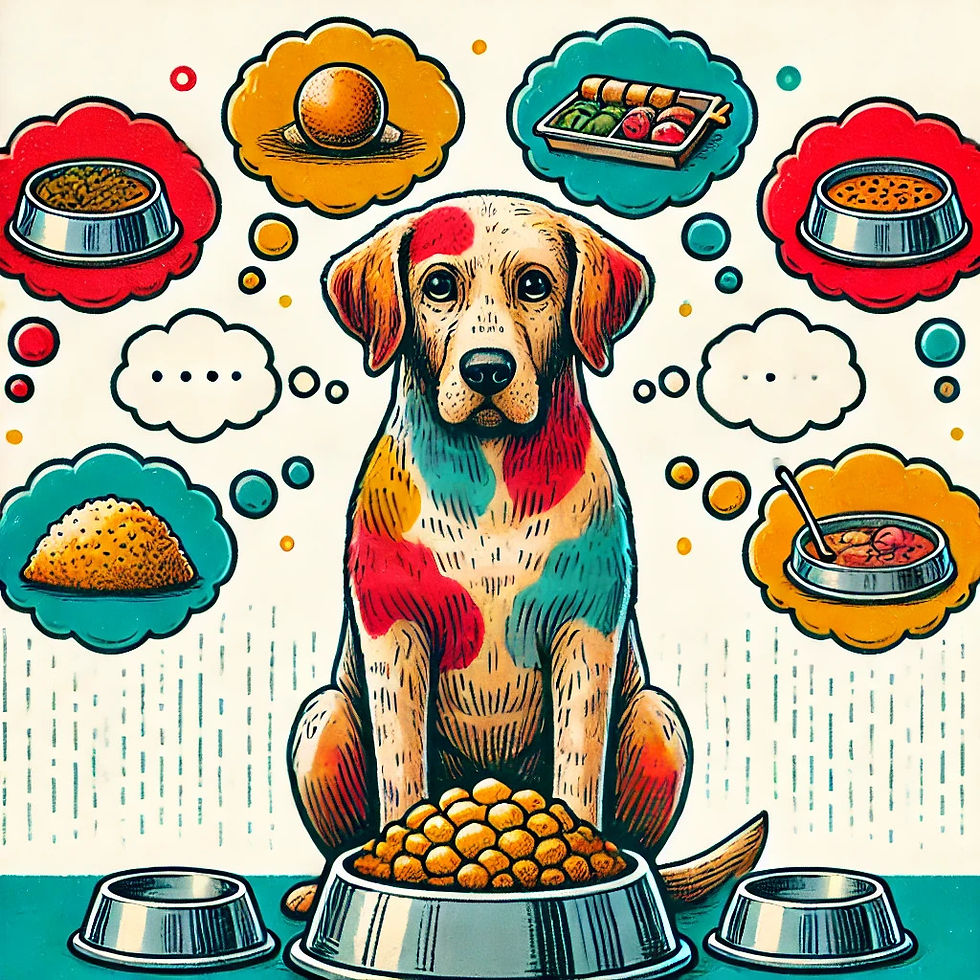How Many Meals a Day Should Your Dog Eat? Science Weighs In (Plus a Real-Life Routine)
- J'adore

- May 6
- 4 min read
Updated: May 13
One, Two, or Three Meals? What’s Best for Your Dog—According to Research, and J’adore.

A very serious investigation. (With minor input from my assistant, June.)
Hi there, hooman. I'm J’adore—tiny in size, big in opinions—and I’m here to answer one of the most debated questions in dogdom: How often should you feed your dog? Once, twice, or thrice a day? 🦴
Now, before you go assuming we dogs just want more food all the time (okay fine, we do), let me walk you through what the science says—and what we do at home, after some trial, error, and a lot of snacking.
🐶 Our Past Routine: 3 Meals a Day
For a long time, June and I were on a three-meals-a-day plan—breakfast, lunch, and dinner. Lunch was usually a slightly smaller portion than the others. In between, we got two snacks—which, if I’m honest, were the highlight of my day.
But things have changed recently, and surprisingly, I’m on board with it (most of the time).
🍽️ Our Current Plan: 2 Meals + A Midday Egg
We now eat two hearty meals—breakfast and dinner—and instead of lunch, we get a boiled egg around midday (delicious, 10/10, would recommend).
Instead of two snack sessions, we’ve shifted gears:
Snack 1 is now a chew session—with bones, tracheas, necks, or chicken feet. Keeps us occupied and satisfies the need to gnaw.
Snack 2 is now a snuffle mat or puzzle toy session with a few treats. Keeps our brains sharp and tummies just busy enough.
And instead of any random munchies, we get a bowl of curd + water, especially because I don’t hydrate enough unless you trick me. (Yes, I know. It's a problem. But curd is my weakness.)
So, why the change? Well… because science!
🔬 What the Research Says
Recent studies—especially from the Dog Aging Project—found that dogs fed once a day had:
Lower chances of cognitive decline 🧠
Fewer health issues like kidney and liver disease
Better long-term outcomes in older age
But before you say “Feed once a day? Blasphemy!”—don’t worry. The research is still correlational. It doesn't prove causation, and not every dog is built for long fasting periods.
🐕 Two Meals a Day: The Practical Sweet Spot
Most vets and pet nutritionists recommend two balanced meals a day, and we agree. Here’s why:
It helps maintain blood sugar levels
It supports digestion and energy levels throughout the day
It fits naturally into our circadian rhythm (yes, we have one too!)
For dogs like us—small, active, and charming (especially charming)—two meals a day with a light, functional midday booster (hello, boiled egg) works beautifully.
🐾 What About Three Meals?
That’s ideal for:
Puppies who need steady glucose
Dogs with medical conditions
Super high-energy working dogs or those with fast metabolisms
That’s why we were on three meals when we were younger—and it worked. But now, we’re grown up and ready for efficiency. (Okay, semi-ready.)
🐩 Special Notes for Small Breeds (That’s Me!)
As a tiny dog (ahem, I prefer “petite”), I can tell you we need a bit more consideration.
Small breeds like Shih Tzus (and moi):
Have faster metabolisms 🏃♂️
Can’t eat big meals in one go
Are more prone to fasting-related bile vomiting (been there, barked that)
Often drink less water—so mixing water with something tasty (like curd) helps
For us, two main meals + a nourishing midday snack + functional snack sessions = ideal. Keeps our tummies and brains happy without spiking blood sugar or encouraging boredom-eating.
🧠 TL;DR: What’s Right for Your Dog?
Dog Type/Life Stage | Meals/Day | Notes |
Healthy Adult Large Dogs | 1–2 | New research shows possible health benefits |
Healthy Small Dogs | 2–3 | Fast metabolism, smaller stomachs |
Puppies | 3–4 | Prevents blood sugar dips |
Senior/Ill Dogs | 2–3 | Supports energy and digestion |
🦴 Our Setup In Summary:
Breakfast: Full, hearty meal
Lunch: One perfect boiled egg
Dinner: Full, hearty meal
Snack 1: Chew time (bone, trachea, neck, etc.)
Snack 2: Snuffle mat or puzzle play with water + curd (for hydration, not calories)
📚 References (Yup, I did my homework)
Bray, E.E. et al. (2022). Feeding Frequency and Health Outcomes in Companion Dogs. Frontiers in Veterinary Science
Greco, D.S. (2006). Hypoglycemia in Small Dogs and Puppies. Veterinary Clinics of North America.
Fascetti, A.J., Delaney, S.J. (2012). Applied Veterinary Clinical Nutrition.
Bjornvad, C.R. et al. (2020). Meal Frequency and Feeding Behavior in Small Breeds. Journal of Small Animal Practice.
AVMA. (2024). Feeding and Wellness Guidelines for Dogs.
Wallis, L.J. et al. (2024). Feeding Patterns and Canine Cognition.
That’s all from me,J’adore—resident food critic, part-time snuggler, full-time genius 🐾
(P.S. June says hi and agrees with everything. She’s busy with her snuffle mat right now.)
Wondering how many meals a day should your dog eat? This science-backed article explores 1, 2, and 3 meal schedules—and shares a real-life routine from J’adore and June.
how many meals a day should your dog eat | dog feeding schedule | best feeding routine for dogs | how often to feed a dog | dog meal frequency | feeding dogs once vs twice a day | small breed dog feeding | shih tzu feeding routine | dog nutrition facts | how many times should I feed my small dog | is it better to feed dogs once or twice a day | how many meals should a shih tzu eat | what’s the best dog feeding schedule | science-backed dog feeding advice | real-life dog feeding schedule example | best meal routine for small breed dogs






Comments